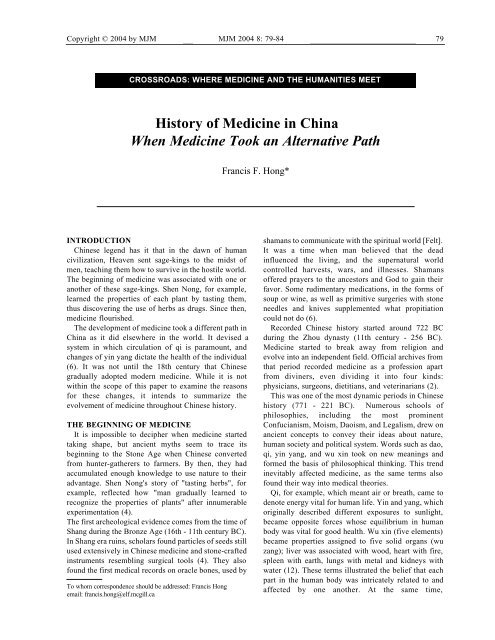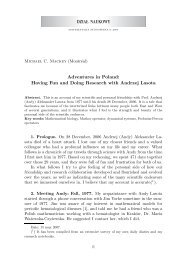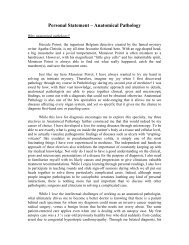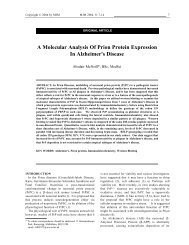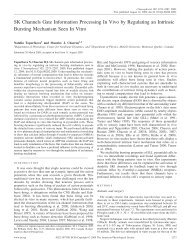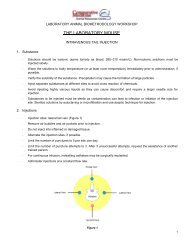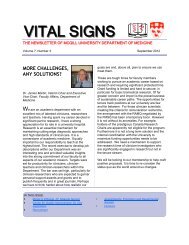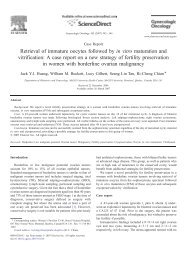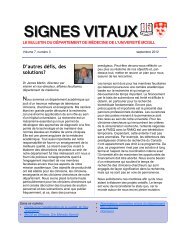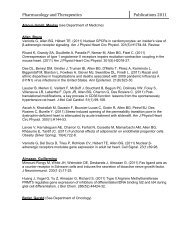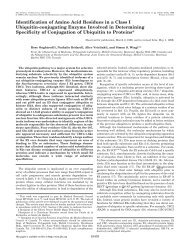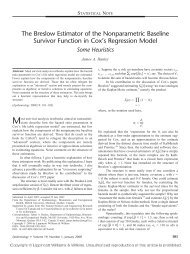History of Medicine in China When Medicine ... - McGill University
History of Medicine in China When Medicine ... - McGill University
History of Medicine in China When Medicine ... - McGill University
You also want an ePaper? Increase the reach of your titles
YUMPU automatically turns print PDFs into web optimized ePapers that Google loves.
Copyright © 2004 by MJM<br />
MJM 2004 8: 79-84 79<br />
CROSSROADS: WHERE MEDICINE AND THE HUMANITIES MEET<br />
H i s t o r y o f M e d i c i n e i n C h i n a<br />
<strong>When</strong> <strong>Medic<strong>in</strong>e</strong> Took an Alternative Path<br />
I N T R O D U C T I O N<br />
Ch<strong>in</strong>ese legend has it that <strong>in</strong> the dawn <strong>of</strong> human<br />
civilization, Heaven sent sage-k<strong>in</strong>gs to the midst <strong>of</strong><br />
men, teach<strong>in</strong>g them how to survive <strong>in</strong> the hostile world.<br />
The beg<strong>in</strong>n<strong>in</strong>g <strong>of</strong> medic<strong>in</strong>e was associated with one or<br />
another <strong>of</strong> these sage-k<strong>in</strong>gs. Shen Nong, for example,<br />
learned the properties <strong>of</strong> each plant by tast<strong>in</strong>g them,<br />
thus discover<strong>in</strong>g the use <strong>of</strong> herbs as drugs. S<strong>in</strong>ce then,<br />
medic<strong>in</strong>e flourished.<br />
The development <strong>of</strong> medic<strong>in</strong>e took a different path <strong>in</strong><br />
Ch<strong>in</strong>a as it did elsewhere <strong>in</strong> the world. It devised a<br />
system <strong>in</strong> which circulation <strong>of</strong> qi is paramount, and<br />
changes <strong>of</strong> y<strong>in</strong> yang dictate the health <strong>of</strong> the <strong>in</strong>dividual<br />
(6). It was not until the 18th century that Ch<strong>in</strong>ese<br />
gradually adopted modern medic<strong>in</strong>e. While it is not<br />
with<strong>in</strong> the scope <strong>of</strong> this paper to exam<strong>in</strong>e the reasons<br />
for these changes, it <strong>in</strong>tends to summarize the<br />
evolvement <strong>of</strong> medic<strong>in</strong>e throughout Ch<strong>in</strong>ese history.<br />
T H E B E G I N N I N G O F M E D I C I N E<br />
It is impossible to decipher when medic<strong>in</strong>e started<br />
tak<strong>in</strong>g shape, but ancient myths seem to trace its<br />
beg<strong>in</strong>n<strong>in</strong>g to the Stone Age when Ch<strong>in</strong>ese converted<br />
from hunter-gatherers to farmers. By then, they had<br />
accumulated enough knowledge to use nature to their<br />
advantage. Shen Nong's story <strong>of</strong> "tast<strong>in</strong>g herbs", for<br />
example, reflected how "man gradually learned to<br />
recognize the properties <strong>of</strong> plants" after <strong>in</strong>numerable<br />
experimentation (4).<br />
The first archeological evidence comes from the time <strong>of</strong><br />
Shang dur<strong>in</strong>g the Bronze Age (16th - 11th century BC).<br />
In Shang era ru<strong>in</strong>s, scholars found particles <strong>of</strong> seeds still<br />
used extensively <strong>in</strong> Ch<strong>in</strong>ese medic<strong>in</strong>e and stone-crafted<br />
<strong>in</strong>struments resembl<strong>in</strong>g surgical tools (4). They also<br />
found the first medical records on oracle bones, used by<br />
To whom correspondence should be addressed: Francis Hong<br />
email: francis.hong@elf.mcgill.ca<br />
Francis F. Hong*<br />
shamans to communicate with the spiritual world [Felt].<br />
It was a time when man believed that the dead<br />
<strong>in</strong>fluenced the liv<strong>in</strong>g, and the supernatural world<br />
controlled harvests, wars, and illnesses. Shamans<br />
<strong>of</strong>fered prayers to the ancestors and God to ga<strong>in</strong> their<br />
favor. Some rudimentary medications, <strong>in</strong> the forms <strong>of</strong><br />
soup or w<strong>in</strong>e, as well as primitive surgeries with stone<br />
needles and knives supplemented what propitiation<br />
could not do (6).<br />
Recorded Ch<strong>in</strong>ese history started around 722 BC<br />
dur<strong>in</strong>g the Zhou dynasty (11th century - 256 BC).<br />
<strong>Medic<strong>in</strong>e</strong> started to break away from religion and<br />
evolve <strong>in</strong>to an <strong>in</strong>dependent field. Official archives from<br />
that period recorded medic<strong>in</strong>e as a pr<strong>of</strong>ession apart<br />
from div<strong>in</strong>ers, even divid<strong>in</strong>g it <strong>in</strong>to four k<strong>in</strong>ds:<br />
physicians, surgeons, dietitians, and veter<strong>in</strong>arians (2).<br />
This was one <strong>of</strong> the most dynamic periods <strong>in</strong> Ch<strong>in</strong>ese<br />
history (771 - 221 BC). Numerous schools <strong>of</strong><br />
philosophies, <strong>in</strong>clud<strong>in</strong>g the most prom<strong>in</strong>ent<br />
Confucianism, Moism, Daoism, and Legalism, drew on<br />
ancient concepts to convey their ideas about nature,<br />
human society and political system. Words such as dao,<br />
qi, y<strong>in</strong> yang, and wu x<strong>in</strong> took on new mean<strong>in</strong>gs and<br />
formed the basis <strong>of</strong> philosophical th<strong>in</strong>k<strong>in</strong>g. This trend<br />
<strong>in</strong>evitably affected medic<strong>in</strong>e, as the same terms also<br />
found their way <strong>in</strong>to medical theories.<br />
Qi, for example, which meant air or breath, came to<br />
denote energy vital for human life. Y<strong>in</strong> and yang, which<br />
orig<strong>in</strong>ally described different exposures to sunlight,<br />
became opposite forces whose equilibrium <strong>in</strong> human<br />
body was vital for good health. Wu x<strong>in</strong> (five elements)<br />
became properties assigned to five solid organs (wu<br />
zang); liver was associated with wood, heart with fire,<br />
spleen with earth, lungs with metal and kidneys with<br />
water (12). These terms illustrated the belief that each<br />
part <strong>in</strong> the human body was <strong>in</strong>tricately related to and<br />
affected by one another. At the same time,
80 <strong>McGill</strong> Journal <strong>of</strong> <strong>Medic<strong>in</strong>e</strong><br />
2004<br />
<strong>in</strong>discrim<strong>in</strong>ative usage <strong>of</strong> such concepts for both human<br />
physiology and natural sciences underl<strong>in</strong>ed an ancient<br />
Ch<strong>in</strong>ese belief that human and the universe were<br />
connected <strong>in</strong> mysterious ways (6).<br />
People had ga<strong>in</strong>ed some elementary understand<strong>in</strong>g<br />
about human anatomy, and assigned physiological<br />
functions to these structures. Liver controlled blood<br />
composition; heart controlled blood circulation and<br />
th<strong>in</strong>k<strong>in</strong>g; spleen controlled digestion; lungs controlled<br />
breath<strong>in</strong>g; kidneys control water balance and sperm<br />
production. Hollow organs such as stomach, gallbladder,<br />
<strong>in</strong>test<strong>in</strong>es, bladder as well as an imag<strong>in</strong>ary "triple burner"<br />
or san jiao were grouped <strong>in</strong>to liu fu, primarily responsible<br />
for digestion, deliver<strong>in</strong>g nutrient or transmitt<strong>in</strong>g waste.<br />
There was also documentation <strong>of</strong> bra<strong>in</strong>, pericardium,<br />
uterus and their respective functions [Nei J<strong>in</strong>g].<br />
The meridian or j<strong>in</strong>g luo system was formed dur<strong>in</strong>g<br />
this period as well. The concept <strong>of</strong> meridians <strong>in</strong> the<br />
beg<strong>in</strong>n<strong>in</strong>g referred to blood vessels but by 2nd century<br />
BC, it had separated from "blood pulse" or xie mai,<br />
<strong>in</strong>dicat<strong>in</strong>g imag<strong>in</strong>ary channels that transmitted qi and<br />
connected the organs [Jia 1979]. It was believed that qi<br />
and blood were transformed from nutrients (by the<br />
spleen) and air (by the lungs), then circulate <strong>in</strong> j<strong>in</strong>g luo<br />
xie mai around the body as dictated by the heart [Nei<br />
J<strong>in</strong>g]. Acupuncture po<strong>in</strong>ts were identified and placed<br />
along these meridians.<br />
Diagnosis relied on four standard steps - <strong>in</strong>spection,<br />
listen<strong>in</strong>g, question<strong>in</strong>g, and palpation <strong>of</strong> pulses [Nei<br />
J<strong>in</strong>g]. Among these, the art <strong>of</strong> pulse palpation would<br />
later on become much ref<strong>in</strong>ed, requir<strong>in</strong>g the physician<br />
to dist<strong>in</strong>guish between twenty-four different k<strong>in</strong>ds <strong>of</strong><br />
wrist pulses. <strong>When</strong> comb<strong>in</strong>ed with a detailed history,<br />
<strong>in</strong>spection <strong>of</strong> general appearance, especially that <strong>of</strong> the<br />
eyes, the tongue and the hands, as well as listen<strong>in</strong>g <strong>of</strong><br />
patients' voice, Ch<strong>in</strong>ese medical practitioners were<br />
expected to f<strong>in</strong>d the diseased meridian (13).<br />
Methods <strong>of</strong> treatment at the time <strong>in</strong>cluded simple<br />
surgical procedures, acupuncture, moxibustion, drugs,<br />
as well as acupressure, physical exercises,<br />
hydrotherapy, even simple psychotherapy that uses<br />
emotional adjustment to alleviate illnesses.<br />
Acupuncture as the core therapy, was quite ref<strong>in</strong>ed by<br />
the end <strong>of</strong> 2nd century BC, <strong>in</strong>volv<strong>in</strong>g n<strong>in</strong>e different<br />
needles and many techniques. Although the role <strong>of</strong><br />
herbal drugs was less significant, physicians had at their<br />
disposal at least 50 regiments for oral <strong>in</strong>gestion, and<br />
more than 90 for external application (6).<br />
Physicians attributed causes <strong>of</strong> illness to seasons,<br />
weather, diet, human activities and emotions, all <strong>of</strong><br />
which disturb the balance between y<strong>in</strong> and yang,<br />
thereby affect<strong>in</strong>g the flow <strong>of</strong> qi. They put preventative<br />
medic<strong>in</strong>e on the foremost position, stress<strong>in</strong>g that<br />
diseases are better treated before their manifestation (7).<br />
Texts dated from 2nd century BC warned aga<strong>in</strong>st b<strong>in</strong>ge<br />
eat<strong>in</strong>g or dr<strong>in</strong>k<strong>in</strong>g, spicy diet, overexertion, excessive<br />
emotions, and extremes <strong>of</strong> temperature. At the same<br />
time, physicians also realized the importance <strong>of</strong><br />
hygiene. Governments constructed sewage systems <strong>in</strong><br />
larger cities; people were advised to do regular house<br />
clean<strong>in</strong>g and avoid dr<strong>in</strong>k<strong>in</strong>g contam<strong>in</strong>ated water (6).<br />
With the development <strong>of</strong> medic<strong>in</strong>e, pr<strong>of</strong>essional<br />
ethics also took shape. One text notes, "to make<br />
diagnosis without an adequate knowledge <strong>of</strong> Y<strong>in</strong> and<br />
Yang... is the first fault on the part <strong>of</strong> physician", "... to<br />
advertise one's medical skills falsely, to apply needles<br />
<strong>in</strong>discrim<strong>in</strong>ately, to cause suffer<strong>in</strong>g to the patient<br />
unnecessarily, is to commit the second fault <strong>in</strong><br />
treatment" (8).<br />
Possibly dur<strong>in</strong>g the 3rd century BC, medical<br />
pr<strong>of</strong>essionals made a comprehensive review <strong>of</strong> the<br />
predom<strong>in</strong>ant theories and practices, by compil<strong>in</strong>g the<br />
oldest Ch<strong>in</strong>ese medical text still <strong>in</strong> existence, Huang Di<br />
Nei J<strong>in</strong>g or "Yellow Emporer's Classic <strong>of</strong> Internal<br />
<strong>Medic<strong>in</strong>e</strong>", which formed the basis <strong>of</strong> medic<strong>in</strong>e for<br />
Ch<strong>in</strong>ese physicians <strong>in</strong> the com<strong>in</strong>g ages (13). In the<br />
thousands <strong>of</strong> years that followed, Ch<strong>in</strong>ese medic<strong>in</strong>e<br />
never deviated significantly from the basic framework<br />
created dur<strong>in</strong>g this period.<br />
T H E D E V E L O P M E N T O F M E D I C I N E<br />
The establishment <strong>of</strong> a unified Ch<strong>in</strong>ese empire <strong>in</strong> 206<br />
BC marked the end <strong>of</strong> five centuries <strong>of</strong> warfare amongst<br />
Ch<strong>in</strong>ese states as well as the defeat <strong>of</strong> the Huns <strong>in</strong> the<br />
west. Ch<strong>in</strong>ese <strong>in</strong>tellectuals were f<strong>in</strong>ally able to focus on<br />
collect<strong>in</strong>g and collat<strong>in</strong>g writ<strong>in</strong>gs from the past<br />
centuries, hop<strong>in</strong>g to rediscover ancient wisdom that<br />
would serve them as guidance <strong>in</strong> every aspect <strong>of</strong> society<br />
and <strong>in</strong>dividual life. Many <strong>of</strong> ancient compositions were<br />
elevated to the level <strong>of</strong> reverence. Huang Di Nei J<strong>in</strong>g<br />
similarly ga<strong>in</strong>ed this status and became the supreme<br />
authority <strong>in</strong> the medical community.<br />
Although the framework laid out by Huang Di Nei J<strong>in</strong>g<br />
was unchallenged, medical practitioners sought to<br />
<strong>in</strong>corporate new experiences as they put old wisdom to<br />
practice. Nan J<strong>in</strong>g (Classic <strong>of</strong> Difficult Problems) <strong>of</strong> 1st<br />
century BC reflected this development, as it sought to<br />
clarify old concepts and perfect the classical theories by<br />
expla<strong>in</strong><strong>in</strong>g and expand<strong>in</strong>g on eight one passages<br />
selected from Huang Di Nei J<strong>in</strong>g (12). Compared to<br />
Huang Di Nei J<strong>in</strong>g, the descriptions and treatments <strong>of</strong><br />
ailments were more detailed <strong>in</strong> this book, with most<br />
known entities characterized and named, then sorted<br />
<strong>in</strong>to more than thirty different categories (6).<br />
Due to its transmissible nature, one disease category,<br />
Shang Han Re B<strong>in</strong>g, which <strong>in</strong>cluded mostly <strong>in</strong>fectious<br />
diseases caus<strong>in</strong>g fever, was extensively studied, with<br />
their symptomatology, natural history and treatment
Vol. 8 No. 1<br />
pr<strong>in</strong>ciples documented <strong>in</strong> Shang Han Za B<strong>in</strong>g Lun <strong>of</strong><br />
the 2nd century AD. The value <strong>of</strong> this book, however,<br />
goes beyond the detailed description it devoted to<br />
<strong>in</strong>fectious diseases. Rather than focus<strong>in</strong>g on treat<strong>in</strong>g the<br />
symptoms, the book reflected an <strong>in</strong>creas<strong>in</strong>g emphasis<br />
on treatment variation "accord<strong>in</strong>g to <strong>in</strong>dividual<br />
pathological case", as it stressed change <strong>of</strong> strategies<br />
accord<strong>in</strong>g to the affected meridian (6). Both Nan J<strong>in</strong>g<br />
and Shang Han Za B<strong>in</strong>g Lun were soon canonized by<br />
the medical community alongside Huang Di Nei J<strong>in</strong>g,<br />
and became must-read for all physicians.<br />
From Huang Di Nei J<strong>in</strong>g to Nan J<strong>in</strong>g, then to Shang<br />
Han Za B<strong>in</strong>g Lun, it illustrated a peculiar trend <strong>in</strong> the<br />
development <strong>of</strong> Ch<strong>in</strong>ese medic<strong>in</strong>e - as people<br />
accumulated more knowledge and became <strong>in</strong>creas<strong>in</strong>gly<br />
ref<strong>in</strong>ed at diagnos<strong>in</strong>g diseases and f<strong>in</strong>d<strong>in</strong>g more effective<br />
treatments, the development <strong>of</strong> medical theories<br />
stagnated. For centuries that followed, no one attempted<br />
to challenge the system <strong>of</strong> y<strong>in</strong>g yan and wu x<strong>in</strong>g.<br />
S<strong>in</strong>ce then, almost every dynasty compiled textbooks<br />
that attempted to epitomize all known medical<br />
knowledge at the time, <strong>of</strong>ten efforts sponsored by the<br />
government. For example, Zhu B<strong>in</strong>g Yuan Hou Lun<br />
(Treatise on the Causes and Symptoms <strong>of</strong> Maladies) <strong>in</strong><br />
610 aimed at be<strong>in</strong>g a general medical textbook,<br />
detail<strong>in</strong>g 1,800 symptoms and signs, discuss<strong>in</strong>g their<br />
etiology, natural history and complications; Wai Tai Bi<br />
Yao (Medical Secrets <strong>of</strong> An Official) <strong>in</strong> 752, on the<br />
other hand, reviewed diagnosis and treatment <strong>of</strong><br />
diseases through discussion <strong>of</strong> 1,140 actual cases (13).<br />
Dur<strong>in</strong>g 11th to 14th century, the government also<br />
compiled several editions <strong>of</strong> medical encyclopedias as<br />
medical reference books.<br />
S<strong>in</strong>ce the <strong>in</strong>vention <strong>of</strong> woodblock pr<strong>in</strong>t<strong>in</strong>g <strong>in</strong> the 10th<br />
century, <strong>in</strong>dividual compilations on medical specialties<br />
also flourished. A number <strong>of</strong> works were written on<br />
<strong>in</strong>ternal medic<strong>in</strong>e, orthopedics, pediatrics, obstetrics<br />
and gynecology, ophthalmology, dermatology etc., and<br />
the first forensic medic<strong>in</strong>e textbook <strong>in</strong> the world was<br />
published <strong>in</strong> 1247. From these books it appeared that<br />
with time, medical practitioners showed more <strong>in</strong>sight<br />
<strong>in</strong>to diagnosis, etiology and treatment <strong>of</strong> <strong>in</strong>fectious<br />
diseases such as typhoid, cholera, malaria, tuberculosis,<br />
and leprosy, as well as foreign ones such as syphilis and<br />
gonorrhea. More subtle ailments such as diabetes also<br />
came <strong>in</strong>to their attention. The pediatrics treatises<br />
provided advice on childhood nutrition and disease<br />
prevention, and showed much better understand<strong>in</strong>g <strong>of</strong><br />
"eruptive fevers such as smallpox, chickenpox and<br />
measles, <strong>in</strong> terms both <strong>of</strong> symptomatology and <strong>of</strong><br />
therapy"; the obstetrics texts recognized the need for<br />
precaution with drugs dur<strong>in</strong>g pregnancy and acquired a<br />
number <strong>of</strong> techniques to deal with dystocias (4).<br />
Although <strong>of</strong>ten ridden with errors and superstition,<br />
<strong>History</strong> <strong>of</strong> <strong>Medic<strong>in</strong>e</strong> <strong>in</strong> Ch<strong>in</strong>a 81<br />
these books recorded the progress <strong>of</strong> Ch<strong>in</strong>ese medic<strong>in</strong>e<br />
and represented some <strong>of</strong> the most sophisticated medical<br />
knowledge at the time (6).<br />
Acupuncture, <strong>of</strong>ten comb<strong>in</strong>ed with moxibustion,<br />
rema<strong>in</strong>ed one <strong>of</strong> the ma<strong>in</strong> treatment modalities <strong>in</strong><br />
Ch<strong>in</strong>ese medic<strong>in</strong>e. Zhen Jiu Jia Yi J<strong>in</strong>g (The ABCs <strong>of</strong><br />
Acupuncture and Moxibustion) <strong>in</strong> 282 AD reviewed the<br />
exist<strong>in</strong>g knowledge and experience on the subject up to<br />
that time, and rema<strong>in</strong>ed an important acupuncture<br />
textbook for centuries to come (6). On the other hand,<br />
the limit <strong>of</strong> its therapeutic effect was quickly<br />
recognized. Drugs thus became more prom<strong>in</strong>ent <strong>in</strong><br />
treatment.<br />
Shen Nong Ben Cao J<strong>in</strong>g <strong>of</strong> 1st century AD was the<br />
first materia medica compiled to meet the grow<strong>in</strong>g need<br />
for herbal medic<strong>in</strong>e, record<strong>in</strong>g 365 drugs <strong>of</strong> herbal,<br />
animal and m<strong>in</strong>eral orig<strong>in</strong>, classified by the degree <strong>of</strong><br />
toxicity. "Superior" drugs (e.g. g<strong>in</strong>seng) are non-toxic<br />
and can be used <strong>in</strong> relatively large doses for their<br />
<strong>in</strong>vigorat<strong>in</strong>g effect; "<strong>in</strong>ferior" drugs (e.g. croton) are<br />
toxic and should be used with caution for their<br />
therapeutic values. The property <strong>of</strong> each drug was<br />
recorded <strong>in</strong> terms <strong>of</strong> their <strong>in</strong>fluence on qi to expla<strong>in</strong><br />
their effect with various types <strong>of</strong> diseases. The<br />
pharmacok<strong>in</strong>etic <strong>in</strong>teractions were also recorded to help<br />
determ<strong>in</strong>e the right drug comb<strong>in</strong>ation (6).<br />
As more herbs were be<strong>in</strong>g discovered for their<br />
therapeutic effects, materia medica had to be revised<br />
with each pass<strong>in</strong>g age. X<strong>in</strong> Xiu Ben Cao (Newly-revised<br />
Materia Medica) <strong>in</strong> 659, the first Ch<strong>in</strong>ese <strong>of</strong>ficial<br />
pharmacopoeia, recorded 850 drugs; the <strong>of</strong>ficial<br />
pharmacopoeias <strong>in</strong> the 10th and 11th century extended<br />
the number <strong>of</strong> drugs to 1,748, and <strong>in</strong>cluded illustrations<br />
to help their recognition [Said 1965]. The most<br />
important work was compiled <strong>in</strong> 1579. Ben Cao Gang<br />
Mu (Compendium <strong>of</strong> Materia Medica), one <strong>of</strong> the most<br />
popular works on Ch<strong>in</strong>ese medic<strong>in</strong>e, "expanded the<br />
content <strong>of</strong> the materia medica to 1,892 drugs, revised<br />
drug classifications, corrected errors <strong>in</strong> its predecesors<br />
and established guidel<strong>in</strong>es for the preparations as well<br />
as the usage <strong>of</strong> drugs" (4).<br />
As Ch<strong>in</strong>ese medic<strong>in</strong>e rarely employed one drug alone<br />
<strong>in</strong> treatment, an <strong>in</strong>creas<strong>in</strong>gly number <strong>of</strong> work also<br />
appeared, teach<strong>in</strong>g physicians time-honored formularies<br />
that had already been proven effective <strong>in</strong> treat<strong>in</strong>g<br />
illnesses. The most famous <strong>of</strong> these, Qian J<strong>in</strong> Fang<br />
(Thousand Gold Remedies) <strong>of</strong> the 7th century collected<br />
5,300 prescriptions that became an important reference<br />
for doctors <strong>in</strong> later centuries. Although they served as<br />
comprehensive reference for physicians, these works<br />
<strong>of</strong>ten "lacked judicious selection", conta<strong>in</strong><strong>in</strong>g treatment<br />
methods from drugs, acupuncture, moxibustion, diet<strong>in</strong>g,<br />
to <strong>in</strong>cantations and exorcism (13). With time, the shear<br />
volume <strong>of</strong> these compilations also became
82 <strong>McGill</strong> Journal <strong>of</strong> <strong>Medic<strong>in</strong>e</strong> 2004<br />
overwhelm<strong>in</strong>g. By the 11th century, governmentpublished<br />
medical reference books conta<strong>in</strong>ed as many<br />
as 20,000 prescriptions. With the multitude <strong>of</strong> therapies<br />
available, physicians became <strong>in</strong>creas<strong>in</strong>gly selective,<br />
reta<strong>in</strong><strong>in</strong>g more effective prescriptions and acupuncture<br />
po<strong>in</strong>ts, based on the treatment pr<strong>in</strong>ciples outl<strong>in</strong>ed by<br />
Shang Han Za B<strong>in</strong>g Lun (6).<br />
The development <strong>of</strong> Ch<strong>in</strong>ese pharmacology was<br />
enhanced by Daoist practice <strong>of</strong> alchemy dur<strong>in</strong>g 3rd to<br />
7th century. While the consumption <strong>of</strong> alchemist<br />
products led to many cases <strong>of</strong> poison<strong>in</strong>g, this practice<br />
nevertheless promoted the development <strong>of</strong><br />
pharmaceutical science, "pav<strong>in</strong>g the way to emergence<br />
<strong>of</strong> a chemical pharmacy". By 5th century, a work<br />
appeared "specifically devoted to the manufacture <strong>of</strong><br />
medic<strong>in</strong>es" from raw materials <strong>of</strong> m<strong>in</strong>eral and herbal<br />
orig<strong>in</strong> (4). Recipes for manufactured medic<strong>in</strong>e <strong>of</strong>ten<br />
came from well-known regimens used for common<br />
symptoms, that were relatively cheap, safe and<br />
effective. S<strong>in</strong>ce they required no prescription and no<br />
tedious preparation, they quickly ga<strong>in</strong>ed popularity<br />
among the masses (13). By the 10th century,<br />
government started sett<strong>in</strong>g up agencies to manufacture<br />
these over-the-counter drugs and open<strong>in</strong>g public<br />
dispensaries, which helped to ease demand for health<br />
care <strong>in</strong> a boom<strong>in</strong>g population (6).<br />
In contrast, certa<strong>in</strong> treatment methods, especially<br />
surgery, received little attention from the medical<br />
community. S<strong>in</strong>ce the depiction <strong>of</strong> the first successful<br />
laparotomy <strong>in</strong> the 2nd century AD, no other attempt was<br />
made over the next few thousand years. Surgeons<br />
limited their role to treat<strong>in</strong>g sk<strong>in</strong> ailments such as ulcers<br />
and boils, and physical <strong>in</strong>juries such as fractures and<br />
dislocations. This uneven development is <strong>of</strong>ten<br />
attributed to the reluctance or even taboo <strong>in</strong> traditional<br />
Ch<strong>in</strong>ese culture to disfigure the body (9). Accord<strong>in</strong>gly,<br />
the development <strong>of</strong> anatomical knowledge also<br />
stagnated. Their depiction <strong>of</strong> human anatomy<br />
progressed little s<strong>in</strong>ce Huang Di Nei J<strong>in</strong>g, and was once<br />
described as "as if someone saw the <strong>in</strong>complete<br />
dissection <strong>of</strong> <strong>in</strong>ternal body and… filled out the<br />
rema<strong>in</strong><strong>in</strong>g parts from imag<strong>in</strong>ation". It was not until the<br />
19th century when surgeons attempted to remedy this<br />
deficiency, but their impact was limited at best (6).<br />
Honor<strong>in</strong>g Huang Di Nei J<strong>in</strong>g's emphasis on disease<br />
prevention, Ch<strong>in</strong>ese physicians also sought for ways to<br />
improve people's health through diet and exercise. In<br />
the 2nd century AD, a system <strong>of</strong> exercise known as<br />
"frolics <strong>of</strong> five animals" was developed from ancient<br />
physical and meditation exercises, and served as the<br />
<strong>in</strong>spiration <strong>of</strong> a multitude <strong>of</strong> systemic exercises that<br />
developed later on, the most famous be<strong>in</strong>g Yang-style<br />
Tai Ji quan (or Tai chi) (6). Preventative medic<strong>in</strong>e also<br />
stressed the values <strong>of</strong> balanced eat<strong>in</strong>g, and over time<br />
<strong>in</strong>corporated food <strong>in</strong>to the system <strong>of</strong> y<strong>in</strong>g yan and wu<br />
x<strong>in</strong>g. By the 13th century, it had established an<br />
important role as preventative and adjunctive therapy,<br />
and dietitians taught adjustments <strong>in</strong> the selection <strong>of</strong><br />
food, cook<strong>in</strong>g and flavor accord<strong>in</strong>g to physical health<br />
and seasons. Many <strong>of</strong> their advices are still be<strong>in</strong>g<br />
valued today (4).<br />
Governments played a significant role <strong>in</strong> preventative<br />
medic<strong>in</strong>e as it paid particular attention to public<br />
sanitation, construct<strong>in</strong>g sewage systems <strong>in</strong> the cities,<br />
employ<strong>in</strong>g road-sweepers and night-soil collectors. As<br />
late as the 19th century, the Ch<strong>in</strong>ese capital was still<br />
described as "unrivaled among the cities <strong>of</strong> the world"<br />
<strong>in</strong> its dra<strong>in</strong>age system (13). There were also records on<br />
construction <strong>of</strong> state hospitals and orphanages from<br />
10th to 13th century.<br />
Preventative medic<strong>in</strong>e played an especially important<br />
role <strong>in</strong> the management <strong>of</strong> <strong>in</strong>fectious epidemics. As<br />
early as the 3rd century AD, people had learned to use<br />
prophylactic drugs and quarant<strong>in</strong>e <strong>of</strong> patients to control<br />
spread <strong>of</strong> epidemics. Later on, they also learned to<br />
dis<strong>in</strong>fect by soak<strong>in</strong>g patients' clothes <strong>in</strong> hot water to<br />
protect their family members (6). The most important<br />
development probably took place <strong>in</strong> the 16th century, as<br />
books described a popular practice <strong>in</strong> which small<br />
amount <strong>of</strong> pustules from smallpox patients were<br />
<strong>in</strong>oculated <strong>in</strong> the nostrils <strong>of</strong> healthy subjects for disease<br />
prevention. This crude method represented the first<br />
vacc<strong>in</strong>ation <strong>in</strong> the world, and was later <strong>in</strong>troduced to<br />
Russia, Japan, Byzant<strong>in</strong>e and several other countries (1).<br />
The growth <strong>of</strong> knowledge was accompanied by a<br />
growth <strong>of</strong> awareness <strong>in</strong> pr<strong>of</strong>essional ethics. In the first<br />
chapter <strong>of</strong> Qian J<strong>in</strong> Fang, for example, the author<br />
stressed: "A great doctor... should have mercy on the<br />
sick and pledge himself to relieve suffer<strong>in</strong>g among all<br />
classes... He should look upon the misery <strong>of</strong> the patient<br />
as if it were his own and be anxious to relieve the<br />
distress, disregard<strong>in</strong>g his own <strong>in</strong>conveniences..." (8)<br />
Similar emphasis on ethical practice <strong>of</strong> medic<strong>in</strong>e was<br />
repeated <strong>in</strong> the medical compilations <strong>of</strong> every dynasty,<br />
primarily focus<strong>in</strong>g on the pr<strong>in</strong>ciples <strong>of</strong> pr<strong>of</strong>essionalism<br />
and benevolence, which was reflected <strong>in</strong> veneration for<br />
life, respect for patients, and universality <strong>of</strong> care (14).<br />
Some textbooks also cited medical confidentiality as<br />
one <strong>of</strong> card<strong>in</strong>al rules that physicians needed to follow.<br />
In the absence <strong>of</strong> particular rules and regulations, these<br />
qualities were ma<strong>in</strong>ly achieved through self-cultivation.<br />
As medic<strong>in</strong>e developed, quality control <strong>of</strong> medical care<br />
became <strong>in</strong>creas<strong>in</strong>gly important. In 442, the first medical<br />
college was established. Until then, the only means to<br />
medical education had been dependent on the system <strong>of</strong><br />
apprenticeship. The new system sought to standardize<br />
the quality <strong>of</strong> physicians who served the emperor. The<br />
students were required to specialize <strong>in</strong> one <strong>of</strong> four
Vol. 8 No. 1<br />
areas: <strong>in</strong>ternal medic<strong>in</strong>e, surgery, pediatrics, or<br />
otorh<strong>in</strong>olaryngology-ophthalmology-dentistry. At the<br />
end <strong>of</strong> their tra<strong>in</strong><strong>in</strong>g, qualification exams were held to<br />
grade their performance (6). In the 11th century,<br />
government broadened the scale <strong>of</strong> medical school and<br />
established regular schools <strong>in</strong> many parts <strong>of</strong> the country.<br />
Through a system <strong>of</strong> competitive exam<strong>in</strong>ations,<br />
physicians were selected for positions <strong>in</strong> government<br />
adm<strong>in</strong>istration and medical education (13).<br />
By late 17th century, however, Ch<strong>in</strong>ese medic<strong>in</strong>e<br />
entered a period <strong>of</strong> "relative decl<strong>in</strong>e". As the regimes<br />
encouraged return to classic scriptures and disapproved<br />
<strong>of</strong> new ideas, the Imperial Medical College<br />
"degenerated to recit<strong>in</strong>g classics <strong>in</strong> the library", and the<br />
medical community at large paid little attention to new<br />
theories and new discoveries (6). Public health system<br />
was chaotic - no standardized exam<strong>in</strong>ation was <strong>in</strong> place<br />
for quality control, some medical practitioners never<br />
received a formal education, and regular practitioners<br />
"have to compete with the herbalists, street dentists,<br />
medic<strong>in</strong>e vendors, barber surgeons … who strive with<br />
on another <strong>in</strong> prey<strong>in</strong>g on the ignorance and credulity <strong>of</strong><br />
the masses". Consequently, people viewed the medical<br />
pr<strong>of</strong>ession with suspicion, and <strong>of</strong>ten would rather resort<br />
to superstitious practices such as <strong>in</strong>cantation and<br />
exorcism for treatment (13). Public sanitation also<br />
worsened drastically. Overcrowd<strong>in</strong>g, floods, drought,<br />
fam<strong>in</strong>e, local bandits and rebellions led to significant<br />
deterioration <strong>in</strong> the general standard <strong>of</strong> liv<strong>in</strong>g (3).<br />
It was then foreign, especially European <strong>in</strong>fluences<br />
started to prevail <strong>in</strong> Ch<strong>in</strong>a. Ch<strong>in</strong>ese came to know a<br />
branch <strong>of</strong> medic<strong>in</strong>e unlike any other they had contacted<br />
before. It was known as western medic<strong>in</strong>e.<br />
W H E N T H E E A S T M E E T S T H E W E S T<br />
By that time, the Renaissance and the Reformation<br />
had transformed Europe and medic<strong>in</strong>e was start<strong>in</strong>g to<br />
benefit from modern sciences. European <strong>in</strong>teraction<br />
with the rest <strong>of</strong> the world expanded. The first<br />
westerners to reach Ch<strong>in</strong>a were the Christian<br />
missionaries.<br />
Dur<strong>in</strong>g the 17th and 18th century, several Jesuit<br />
missionaries enjoyed considerable prestige <strong>in</strong> the<br />
Ch<strong>in</strong>ese imperial court. The herbal medic<strong>in</strong>es they<br />
brought from Europe, such as such as qu<strong>in</strong>qu<strong>in</strong>a, were<br />
readily <strong>in</strong>corporated <strong>in</strong>to Ch<strong>in</strong>ese pharmacology (4). In<br />
1805, Jennerian anti-smallpox vacc<strong>in</strong>ation was<br />
<strong>in</strong>troduced to Ch<strong>in</strong>a, rapidly replac<strong>in</strong>g the old practices<br />
due to superior safety and efficacy. Medical<br />
missionaries <strong>in</strong> the early 1800's also amazed the<br />
Ch<strong>in</strong>ese with their surgical skills, as surgery <strong>in</strong> Ch<strong>in</strong>a<br />
were still underdeveloped. The first missionary hospital<br />
was founded <strong>in</strong> 1834, the first western medical school<br />
opened <strong>in</strong> 1866 (3). S<strong>in</strong>ce then, the westerners opened<br />
<strong>History</strong> <strong>of</strong> <strong>Medic<strong>in</strong>e</strong> <strong>in</strong> Ch<strong>in</strong>a 83<br />
many centers for health care and physician tra<strong>in</strong><strong>in</strong>g <strong>in</strong><br />
major cities. Impressed by western medic<strong>in</strong>e, many<br />
Ch<strong>in</strong>ese scholars also went abroad to study.<br />
Yet as European explorers and merchants poured <strong>in</strong>to<br />
this land, the <strong>in</strong>itially peaceful <strong>in</strong>teraction turned <strong>in</strong>to a<br />
malicious conflict. The first Opium War <strong>in</strong> 1839 ended<br />
with Ch<strong>in</strong>ese defeat. As the Europeans, the Americans,<br />
and the Japanese asserted their power <strong>in</strong> Ch<strong>in</strong>a, the<br />
k<strong>in</strong>gdom was rapidly reduced to a semi-colony.<br />
Pervasive disillusionment <strong>in</strong> the monarchy led to its<br />
downfall <strong>in</strong> 1911. The Nationalists led by Dr. Sun<br />
Zhong Shan (Sun Yat-sen), equipped with western<br />
political ideals, founded the first Ch<strong>in</strong>ese republic.<br />
The public health problem at the time was stagger<strong>in</strong>g.<br />
Early <strong>in</strong>dustrialization <strong>in</strong> the major cities was creat<strong>in</strong>g<br />
new health problems <strong>in</strong> addition to <strong>in</strong>creas<strong>in</strong>gly rural<br />
impoverishment. Epidemics <strong>of</strong> malaria, cholera,<br />
trachoma, dysentery, typhoid, smallpox etc. broke out<br />
with <strong>in</strong>creas<strong>in</strong>gly short <strong>in</strong>tervals. [Hillier 1983] Hav<strong>in</strong>g<br />
resisted developments <strong>in</strong> their own community as well<br />
as the scientific discoveries from the west, the<br />
traditional medical community was ill equipped to deal<br />
with these diseases. In contrast, hav<strong>in</strong>g gone through<br />
the revolution by "germ theory" <strong>in</strong> the mid-1800's,<br />
western medic<strong>in</strong>e proved much more valuable. In 1911,<br />
a British-tra<strong>in</strong>ed doctor successfully directed the<br />
operation to control the epidemic <strong>of</strong> pneumonic plague<br />
<strong>in</strong> Manchuria, giv<strong>in</strong>g a "great fillip to scientific medical<br />
practice throughout Ch<strong>in</strong>a" (6).<br />
With help from foreign tra<strong>in</strong>ed medical graduates, the<br />
Nationalist government took <strong>in</strong>itiatives to improve<br />
public health, especially <strong>in</strong> large urban centers. It<br />
coord<strong>in</strong>ated mass health campaign <strong>in</strong> Fu Zhou <strong>in</strong> 1920,<br />
started midwifery tra<strong>in</strong><strong>in</strong>g <strong>in</strong> basic hygiene <strong>in</strong> 1929, and<br />
launched New Life Movement to abolish drugs and<br />
prostitution <strong>in</strong> 1934. But their efforts were underm<strong>in</strong>ed<br />
by ongo<strong>in</strong>g wars, government corruption, as well as the<br />
reluctance <strong>of</strong> "western-style" doctors to go to rural<br />
areas where medical services were most needed (3).<br />
The policy-makers also hoped that by adopt<strong>in</strong>g<br />
modern scientific medic<strong>in</strong>e, the traditional practice<br />
would be replaced. In 1929, a series <strong>of</strong> measures was<br />
approved to suppress the practice <strong>of</strong> traditional<br />
medic<strong>in</strong>e, <strong>in</strong>clud<strong>in</strong>g prohibit<strong>in</strong>g traditional physicians<br />
"from open<strong>in</strong>g medical schools or hospitals". But the<br />
shortage <strong>of</strong> modern doctors limited the practicality <strong>of</strong><br />
these policies. Moreover, the use <strong>of</strong> traditional medic<strong>in</strong>e<br />
"produced satisfactory enough results <strong>in</strong> the treatment<br />
<strong>of</strong> illness, particularly <strong>in</strong> those which modern sciences<br />
apparently could not cure". Compared to imported<br />
drugs, herbal medications were "cheap, widely<br />
available and easy to use, with few adverse effects".<br />
The attempt to elim<strong>in</strong>ate traditional medic<strong>in</strong>e failed due<br />
to fierce public opposition (4).
84 <strong>McGill</strong> Journal <strong>of</strong> <strong>Medic<strong>in</strong>e</strong> 2004<br />
In 1949, the communists replaced the Nationalist<br />
regime. Like their predecessors, they saw the press<strong>in</strong>g<br />
need to improve public health. New educational<br />
programs tra<strong>in</strong>ed thousands <strong>of</strong> health care workers;<br />
national health campaigns improved public sanitation;<br />
vacc<strong>in</strong>ation programs elim<strong>in</strong>ated epidemics <strong>in</strong> the cities<br />
and reduced their <strong>in</strong>cidence <strong>in</strong> the countryside (4).<br />
See<strong>in</strong>g the value <strong>in</strong> the traditional practice, the<br />
government employed traditional doctors, thereby<br />
<strong>in</strong>corporat<strong>in</strong>g them <strong>in</strong>to the health system. As herbs and<br />
acupuncture spared the need for imported drugs, the<br />
cost <strong>of</strong> public health was reduced and its availability<br />
<strong>in</strong>creased, br<strong>in</strong>g<strong>in</strong>g health care to many underserviced<br />
areas <strong>in</strong> the country. Currently traditional practice still<br />
delivers "almost 40% <strong>of</strong> total health-care services" <strong>in</strong><br />
Ch<strong>in</strong>a (10).<br />
At the same time, the government revolutionized the<br />
practice <strong>of</strong> traditional medic<strong>in</strong>e. They founded colleges<br />
and hospitals for traditional practice, standardized the<br />
education system, <strong>in</strong>corporat<strong>in</strong>g modern sciences <strong>in</strong>to<br />
their curriculum. Dur<strong>in</strong>g the Maoist era, the<br />
government tried to comb<strong>in</strong>e traditional and modern<br />
medic<strong>in</strong>e <strong>in</strong>to a new, improved discipl<strong>in</strong>e; however, its<br />
lack <strong>of</strong> understand<strong>in</strong>g <strong>in</strong> either branch <strong>of</strong> medic<strong>in</strong>e<br />
predicted its failure. Today, the government allows both<br />
discipl<strong>in</strong>es to develop <strong>in</strong>dependently (10).<br />
Traditional physicians, especially those who studied<br />
modern sciences, are encouraged to engage <strong>in</strong> research,<br />
such as <strong>in</strong>vestigation <strong>of</strong> active <strong>in</strong>gredients <strong>in</strong> herbal<br />
medic<strong>in</strong>e, neurophysiology <strong>of</strong> acupuncture etc. They<br />
are also <strong>in</strong>vited to modify the old theories based on new<br />
scientific knowledge (3). The result <strong>of</strong> this<br />
"modernization" rema<strong>in</strong>s to be seen.<br />
Most doctors tra<strong>in</strong>ed <strong>in</strong> modern medic<strong>in</strong>e, on the<br />
other hand, admit that "there is someth<strong>in</strong>g <strong>in</strong> traditional<br />
medic<strong>in</strong>e", despite reta<strong>in</strong><strong>in</strong>g some skepticism. Many <strong>of</strong><br />
them even use traditional medic<strong>in</strong>e for some <strong>of</strong> their<br />
own illnesses (e.g. common cold, athlete's foot etc.).<br />
Traditional medic<strong>in</strong>e's hold on Ch<strong>in</strong>ese, it seems, is still<br />
strong (10).<br />
C O N C L U S I O N<br />
In Ch<strong>in</strong>a, the development <strong>of</strong> medic<strong>in</strong>e took an<br />
entirely different route compared to the West. Instead <strong>of</strong><br />
look<strong>in</strong>g to science for <strong>in</strong>spirations, it endorsed ancient<br />
philosophies, creat<strong>in</strong>g a medic<strong>in</strong>e based on concepts <strong>of</strong><br />
qi and y<strong>in</strong> yang, and practices <strong>of</strong> acupuncture and<br />
herbal drugs. Dur<strong>in</strong>g its three thousand years <strong>of</strong> history,<br />
it pioneered <strong>in</strong> such th<strong>in</strong>gs as vacc<strong>in</strong>ation, diet, exercise<br />
and medical education, and had <strong>in</strong>fluenced medical<br />
practice throughout Asia. Its pr<strong>in</strong>ciples <strong>of</strong> holistic<br />
approach to illnesses, emphasis on uniqueness <strong>of</strong><br />
<strong>in</strong>dividual cases, <strong>in</strong>teractions between organs, disease<br />
prevention with diet and exercises, and awareness <strong>of</strong><br />
environmental <strong>in</strong>fluences prove valuable even today.<br />
In a world revolutionized by science and technology,<br />
Ch<strong>in</strong>a <strong>in</strong>evitably adopts modern evidence-based<br />
medic<strong>in</strong>e. On the other hand, unwill<strong>in</strong>g to give up<br />
traditional wisdom, Ch<strong>in</strong>ese endorses a health system<br />
that <strong>in</strong>tends to <strong>in</strong>corporate the best <strong>of</strong> both worlds. Will<br />
Ch<strong>in</strong>ese medic<strong>in</strong>e become marg<strong>in</strong>alized and dim<strong>in</strong>ish?<br />
Or will it adapt itself to the world <strong>of</strong> science? The<br />
outcome <strong>of</strong> this thousand year-old practice rema<strong>in</strong>s to<br />
be seen.<br />
REFERENCES<br />
1. Buck C. "Smallpox <strong>in</strong>oculation--should we credit Ch<strong>in</strong>ese<br />
medic<strong>in</strong>e?". Complementary Ther Med. 2003, Sep; 11(3):201-2.<br />
2. Felt, RL. The Ancient <strong>History</strong> <strong>of</strong> Ch<strong>in</strong>ese <strong>Medic<strong>in</strong>e</strong>. URL:<br />
http://www.paradigm-pubs.com/ html/background.html<br />
3. Hillier SM, Jewell JA. Health Care And Traditional <strong>Medic<strong>in</strong>e</strong> In<br />
Ch<strong>in</strong>a, 1800 - 1982. London, UK: Routledge & Kegan Paul,<br />
1983.<br />
4. Hoizey D, Hoizey M-J. A <strong>History</strong> <strong>of</strong> Ch<strong>in</strong>ese <strong>Medic<strong>in</strong>e</strong>. Bailey<br />
P, Translator. Vancouver, Canada: UBC Press, 1993.<br />
5. Huang Di Nei J<strong>in</strong>g. 3rd Century BC. URL: www.cconly.com/neij<strong>in</strong>g1.htm.<br />
6. Jia D. Zhong Guo Yi Xue Shi Lue (A Concise <strong>History</strong> <strong>of</strong><br />
Ch<strong>in</strong>ese <strong>Medic<strong>in</strong>e</strong>). Taiyuan, PRC: Shan Xi Ren M<strong>in</strong>g Chu Ban<br />
She, 1979.<br />
7. Li S. Zhong Yi Li Lun Ti Xi Yan Jiu Fang Xiang Zhi Guang Jian<br />
(Direction <strong>of</strong> Research on Theories <strong>of</strong> Ch<strong>in</strong>ese <strong>Medic<strong>in</strong>e</strong>: A<br />
Personal Op<strong>in</strong>ion). 2001, May 10. URL:<br />
www.ctmrc.com/laoshux<strong>in</strong>hua/yidaozhendi/zmzt6.html.<br />
8. Tsuei W. Roots <strong>of</strong> Ch<strong>in</strong>ese Culture and <strong>Medic<strong>in</strong>e</strong>. Oakland,<br />
USA: Ch<strong>in</strong>ese Culture Books Co. 1989.<br />
9. Said HM. <strong>Medic<strong>in</strong>e</strong> In Ch<strong>in</strong>a. Karachi, Pakistan: Hamdard<br />
Academy, 1965.<br />
10. Scheid V. "Shap<strong>in</strong>g Ch<strong>in</strong>ese <strong>Medic<strong>in</strong>e</strong>: two case studies from<br />
contemporary Ch<strong>in</strong>a". In: Hsu E, Editor. Innovation <strong>in</strong> Ch<strong>in</strong>ese<br />
<strong>Medic<strong>in</strong>e</strong>. Cambridge, UK: Cambridge <strong>University</strong> Press, 2001.<br />
11. Scheid V. "Document the Globalization <strong>of</strong> Ch<strong>in</strong>ese <strong>Medic<strong>in</strong>e</strong>".<br />
Lancet. 1999 Dec; 354 suppl: SIV 10.<br />
12. Unschuld PU. <strong>Medic<strong>in</strong>e</strong> In Ch<strong>in</strong>a: a history <strong>of</strong> ideas. California,<br />
USA: <strong>University</strong> <strong>of</strong> California Press, 1985<br />
13. Wong KC, Wu L-T. <strong>History</strong> <strong>of</strong> Ch<strong>in</strong>ese <strong>Medic<strong>in</strong>e</strong>. Tients<strong>in</strong>,<br />
Ch<strong>in</strong>a: The Tients<strong>in</strong> Press, 1932.<br />
14. Zhang D, Zheng Z. "<strong>Medic<strong>in</strong>e</strong> is a humane art: the basic<br />
pr<strong>in</strong>ciples <strong>of</strong> pr<strong>of</strong>essional ethics <strong>in</strong> Ch<strong>in</strong>ese medic<strong>in</strong>e". Hast<strong>in</strong>gs<br />
Cent Rep. 2000 Jul-Aug;30(4 Suppl):S8-12.<br />
Fracis Feiyu Hong is a second year Family <strong>Medic<strong>in</strong>e</strong> resident at <strong>McGill</strong> <strong>University</strong>. He obta<strong>in</strong>ed his medical degree <strong>in</strong> 2003<br />
and a BSc degree <strong>in</strong> Biochemistry <strong>in</strong> 1998 from <strong>McGill</strong> <strong>University</strong>. He is look<strong>in</strong>g forward to his graduation <strong>in</strong> 2005.


